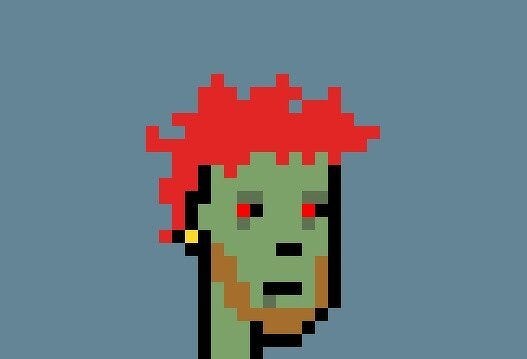
Last year, I outlined an NFT 101 guide explaining just what NFTs are as a way to help mainstream users start to get their heads around non-fungible technologies. Living at the ‘bleeding edge’ of crypto technology over here at Sylo, we could see the writing was on the wall — NFTs were about to come in hot.
Still, it’s almost unbelievable how much the NFT space has blown up since then.
From Beeple’s $69 million masterpiece to an 18 year old artist’s $500,000 vampire queen, 2021 has set, smashed and reset records around how much the world can value non-fungible assets.
Take a look at the top performing NFT collections over the last seven days or the top 10 highest grossing NFT sales of this year so far and you’ll quickly see my point.
THE TOP NFTS ON OPENSEA OVER THE LAST SEVEN DAYS
TOP 10 HIGHEST NFT SALES IN 2021
- Everydays: The First 5000 Days by Beeple — $69.3 Million
- CryptoPunk #7523 — $11.8 Million
- CryptoPunk #7804 — $7.56 Million
- CryptoPunk #3100 — $7.51 Million
- CROSSROAD by Beeple — $6.66 Million
- Ocean Front by Beeple — $6 Million
- CryptoPunk #5217 — $5.44 Million
- World Wide Web source code — $5.43 Million
- CryptoPunk #7252 — $5.3 Million
- Stay Free by Edward Snowden — $5.27 Million






Now if you look past the larger than life price tags, some key threads begin to emerge that signal where NFTs have evolved to…
Value. High art. Subversion. Rebellion. Fundraising. Alternative virtual identities. The Metaverse. Profile Picture NFTs. Composable NFT Games. Play-To-Earn.
And people really, really like CryptoPunks.
But let’s start with art…
HIGH ART
Over the past year, NFTs have evolved from relatively simple collectables to offer in their highest expressions, something that is incredibly valuable, aesthetically beautiful, of high artistic merit, and physically present in society.
NFTs still exist in the digital, but they’re more than a jpeg. And boutique providers are stepping to the fore to forge new ways of creating, displaying, curating, and collecting high art in this new world enabled by NFT technology.
Once likened to digital trading cards, NFTs are now a logical way for artists to create and disperse their artworks, and for the art-loving and tech-savvy to receive them. NFTs can now also be priceless experiences, like going for a ride on a SailGP racing boat, or having a 1-on-1 kicking session with an All Blacks legend.
Platforms such as Glorious, the premium NFT marketplace and creative studio will soon cater to this strongly growing new market, enabling a flip of the status quo that the art world has never seen before.

It’s the technology underpinning NFTs that sets both creator and collector free.
By existing on the blockchain, an NFT artwork exists forever in permanence — it can never be destroyed. ‘Lost masterpieces’ are a thing of the past.
Blockchain solves the problems of provenance — every artwork is traceable in time.
Artworks can now be ‘Non-Fungible’ assets — verifiably unique so there are no more rip offs or counterfeits.
When an NFT artwork is sold, thanks to smart contracts, it can be sold with rules that are enshrined in its very code — such as percentage royalties in perpetuity, every time the asset changes hands.
This overturns the old-school model where gallerists and collectors got rich whilst artists suffered. Fair returns for artists mean they can keep on creating.
This brings me to my next point…
SUBVERSION & REBELLION
Throughout history, forces have driven artists to create. These of course have sometimes been basic motives, such as to make a living or to tell a story. But the best art, the art we globally recognise and that has stood the test of time, has been driven by rebellion. It has been created by those who wanted to do things drastically differently and who were unafraid to create at the ‘bleeding edge’ of what was possible and acceptable in their world.

By embracing NFTs and blockchain, artists now have the choice to create at the forefront of a new world that is already all about subverting the status quo — the world of crypto.
Centred around principles of decentralisation, democratisation, open access, transparency, trustlessness, and fair reward for fair work, the realm of crypto offers creators the opportunity to join a movement larger than themselves.
The real question is — Why wouldn’t people want to be part of a movement that spans the cultural, technological and social, that treats creators more fairly and helps awesome things last forever?
What the crypto world gains from artists joining the fray is a boldly visible, easily understood statement of our values and the kind of world we’re trying to create.
We’re pleased to have them on board with us as we continue our push for fairer, more innovative, more humane ways of providing technology.
FUNDRAISING
The ability to turn just about anything into an NFT, means that value can be found in more places than you can imagine. More than physical objects or their representation, an NFT could even represent a moment in time…
This innate value can then be monetised on the open market to offer a unique way for individuals and organisations to fundraise for worthy causes.

Just look at Edward Snowden’s contribution (number 10) on the highest sellers list above. Snowden sold the artwork for an enormous $5.4 million on community-driven NFT marketplace Foundation, with the proceeds going to the Freedom of the Press Foundation, a non-profit that advocates for free speech, freedom of the press, and public-interest journalism.
Perhaps more interesting however than the price paid, is who bought it: a decentralised autonomous organisation named PleasrDAO, who were formed to acquire “culturally significant pieces with a charitable twist” on behalf of its investors. It’s an example of an investor DAO, a new type of non-hierarchical organisation that pools its resources to make investments.
Now NFTs are not just shaping what is created, but how it’s collected too!
ALTERNATIVE VIRTUAL IDENTITIES & THE METAVERSE
So as I’ve outlined above, in a few slightly more mainstream and easily understood ways, NFTs are expanding to take up space in the public, physical world and that is awesome, but just wait ‘til you get your head around where they are going online…
NFTs are also morphing into something completely unique in online worlds, in the space of virtual identity. Known as ‘profile picture NFTs’ or PFP NFTs for short, in the latest NFT use-case evolution, using an NFT that you verifiably own as your profile picture has become a ticket to being involved with a niche digital community.
Instant access to the ‘in’ crowd, using a PFP NFT is a way for someone to signal that “they understand” the social, cultural, technological, and financial revolution that NFTs pose to our world. It also helps individuals to smoothly attain high social ranking in the virtual world, where they join not just their peers but the ranks of figures such as Jay Z, Snoop Dogg, Shaq, the anonymous 6259 Cryptopunk, and many other celebrities.

Just a week ago, Twitter began publicly testing a new feature to support PFP NFTs by enabling users to display a verified non-fungible token (NFT) as their profile picture.
Sure, it sounds cool, and offers NFT owners a new way to flex the Cryptopunk they bought for the price of a superyacht, but there’s more to it than that. And that ‘more to it’ has a lot to do with a word you’re going to start hearing a lot, the Metaverse.
What is the Metaverse?
Initially designated to Science Fiction, the term was coined way back in 1993, with the ‘metaverse’ referring to a 3D virtual world inhabited by avatars of real people.
Sound familiar? Enter NFTs, social media and virtual reality, and we’re basically there already.
Part ambition, part dream, part reality, the conflux that is the Metaverse is a huge topic in tech right now as we evaluate where we are and aim for the way ahead, whilst evaluating why we might want to go there.
<iframe allowfullscreen="" frameborder="0" height="586" scrolling="auto" src="https://cdn.embedly.com/widgets/media.html?type=text%2Fhtml&key=a19fcc184b9711e1b4764040d3dc5c07&schema=twitter&url=https%3A//twitter.com/punk6529/status/1445486085400772611&image=https%3A//i.embed.ly/1/image%3Furl%3Dhttps%253A%252F%252Fabs.twimg.com%252Ferrors%252Flogo46x38.png%26key%3Da19fcc184b9711e1b4764040d3dc5c07" title="6529 on Twitter: "49/ Today we live in a metaverse composed of twitter and discord avatars and opensea and a bit of various virtual land platforms.Bit by bit, this metaverse will become more real, more tangible, more visual, more rich, more engaging / Twitter"" width="692"></iframe>
<iframe allowfullscreen="" frameborder="0" height="530" scrolling="auto" src="https://cdn.embedly.com/widgets/media.html?type=text%2Fhtml&key=a19fcc184b9711e1b4764040d3dc5c07&schema=twitter&url=https%3A//twitter.com/punk6529/status/1445486088206753799&image=https%3A//i.embed.ly/1/image%3Furl%3Dhttps%253A%252F%252Fabs.twimg.com%252Ferrors%252Flogo46x38.png%26key%3Da19fcc184b9711e1b4764040d3dc5c07" title="6529 on Twitter: "50/ In 10 years, I believe you will not be a 24 x 24px avatar in a text based feed on my laptop screen.In 10 years we will be chilling in some type of augmented and virtual reality that feels quite real.So along the way, we will take steps in that directions / Twitter"" width="692"></iframe>
More than immersion, the Metaverse offers expression, community and new economies.
We already keep in touch online, work online, study online, argue online, find love online, listen and curate music online; we spend so much of our lives online in a truly virtual sense. Admitting we are already part of the Metaverse is just a small shift in perspective, and NFT profile pictures are a small first step in joining the dots.

COMPOSABLE NFT GAMES & PLAY-TO-EARN
There are many facets to the evolution of the Metaverse, and NFT-driven games are worthy of note.
Composable NFT games like Loot and MLoot incentivise the community to build an entire world around a single set of NFTs — an activity that would be impossible without the ownership and portability that Web3 enables.
Go sideways and you’ll find Play-To-Earn NFTs, like Axie Affinity, Gods Unchained and Altered State Machine. These types of NFT driven games allow players to participate in the development of the very game they are playing, simply by playing it. Simplistically, to get started as a player, you need some NFTs to play the game, then you can earn more NFTs or another token by playing, which you can then sell for different tokens or use to buy more NFTs.
This NFT-driven paradigm shift turns the traditional game development model on its head. Whereas the profit structure for traditional games would pay around 70% to the game rights holders and 30% to the app stores, Play-To-Earn games can return around 90% of the profits to the players as rewards and pay 10% to game rights holders.
Where can all this take us next? Stay tuned for our next article…
—
Got questions in the mean time? Get in touch with our team now on Twitter or Telegram, we’d love to hear from you!
Or if you’d like a refresher on the basics of NFTs, go back to our 101 guide in this article.
from: https://medium.com/sylo-io/nfts-in-2021-35c426a9c251
-
Non-Fungible Tokens: 101
by justin July 6, 2022

